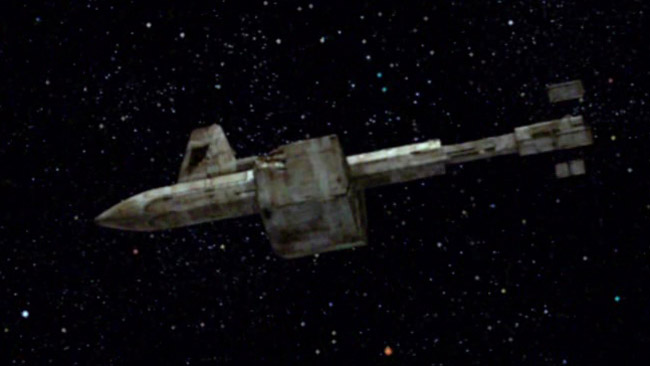Difference between revisions of "DY-100 class (FASA)"
From Trekipedia
(Created page with "{{MyriadDY100}} {{BannerFASA}} {{ImageInfoBox|name=DY-100 class|imgname=dy100-tos24|caption=DY-100 class (TOS 24)}} {{TableRow|title=Adv...") |
m |
||
| Line 1: | Line 1: | ||
{{MyriadDY100}} | {{MyriadDY100}} | ||
{{BannerFASA}} | {{BannerFASA}} | ||
| − | {{ | + | {{ImageInfoBox2|name=DY-100 class|file=dy100-tos24.jpg|caption=DY-100 class ([[Star Trek|TOS]] [[Space Seed (Episode)|24]])}} |
{{TableRow|title=Advertising|data={{AmazonLink2}}}} | {{TableRow|title=Advertising|data={{AmazonLink2}}}} | ||
|}</div> | |}</div> | ||
Revision as of 17:12, 10 October 2020
Myriad Universes: DY-100 class
The DY-100, introduced in 1995, was the first mass-produced spacecraft capable of routine circumlunar (Earth-moon) travel. Interchangeable modules permitted wide diversity of mission profiles, including an upgrade for interplanetary travel that allowed it to take humans to Mars. The class remained in service until 2020.[1]
Specifications[1]
| Length | 100 m |
| Beam | 23.37 m |
| Draught | 34.9 m |
| Mass | 2.72 million kg |
| Living/Fuel/Cargo Units | Interchangeable modules each 27x5.5x6.57m (795m³ usable volume) |
| Engine Section | Combination Chemical/Fission • Diameter: 6.13 m • Length: 19m |
| Command Con | 12.3x7.4x4.9 m |
| Complement | • Officers: 2 • Crew/Passengers: 0-20 |
| Navigation | Optical Tracker-Controlled Inertial Guidance |
| Communications | Laser Radiotelemetry |
| Computer | Standard Program-Dependent Digital Memory |
| Life Support | • Gravity: No internal control • Atmosphere: 34.7% O2; 11% humidity |
Performance[1]
| Range | • Standard: 900,000 km • Maximum: 387 million km (refit for duration travel) |
| Velocity | • Cruising: 55,000 km/hour • Maximum: 80,000 km/hour • Escape Velocity (Earth): 38,000 km/hour |
| Voyage Duration | • Typical (Earth-Moon): 9.2 hours • Maximum (Earth-Mars-Asteropolis-Mars-Earth): 934 days (with supply stops) |
| Thrust | • Chemical: Six chemical boost engines for Earth escape producing 4.2 million kg • Fission: One Amjet hydrogen fission thruster for interplanetary transfer producing 68,000 kg (average) |
DY-100 class vessels
Prime Timeline
Columbia Timeline
LUG Timeline
S.S. Botany Bay DY-109 • S.S. Iberville DY-120 • S.S. Lyons Creek DY-166 • S.S. Monticello DY-158 • S.S. Salisbury DY-131 • S.S. San Juan DY-177 • S.S. Santa Maria DY-164 • S.S. Shenandoah DY-178 • S.S. Wacosta DY-104
FASA Timeline
S.S. Botany Bay • S.S. Copernicus
Kelvin Timeline
Myriad Universes
Notes and References
- ↑ 1.0 1.1 1.2 Goldstein, Stan et al (Authors). Spaceflight Chronology. Star Trek. Book. Wallaby Books. 1980.

